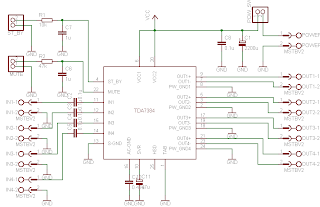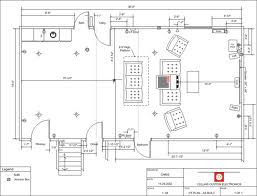The circuit
can also supply motor currents up to 3.5 A, which means it can be used
to drive relatively large motors. The circuit is also short-circuit
proof and has built-in over temperature protection. Two signals are
required for driving a stepper motor. In logical terms, they constitute
a Grey code, which means they are two square-wave signals with the
same frequency but a constant phase difference of 90 degrees.
IC1
generates a square-wave signal with a frequency that can be set using
potentiometer P1. This frequency determines the rpm of the stepper
motor. The Grey code is generated by a decimal counter in the form of a
4017. Outputs Q0–Q9 of the counter go high in succession in response to
the rising edges of the clock signal. The Grey code can be generated
from the outputs by using two OR gates, which are formed here using two
diodes and a resistor for each gate, to produce the I and Q signals.
Here
‘I’ stands for ‘in-phase’ and ‘Q’ for ‘quadrature’, which means it has
a 90-degree phase offset from the I signal. It is common practice to
drive the windings of a stepper motor using a pair of push-pull circuits
for each winding, which is called an ‘H bridge’. That makes it
possible to reverse the direction of the current through each winding,
which is necessary for proper operation of a bipolar motor (one whose
windings do not have centre taps).
Of course, it can also be
used to properly drive a unipolar motor (with centre-tapped windings).
Instead of using a push-pull circuit of this sort, here we decided to
use audio amplifier ICs (type TDA2030), even though that may sound a
bit strange. In functional terms, the TDA2030 is actually a sort of
power opamp. It has a difference amplifier at the input and a push-pull
driver stage at the output.
IC3,
IC4 and IC5 are all of this type (which is economically priced). Here
IC3 and IC4 are wired as comparators. Their non-inverting inputs are
driven by the previously mentioned I and Q signals, with the inverting
inputs set to a potential equal to half the supply voltage. That
potential is supplied by the third TDA2030. The outputs of IC3 and IC4
thus track their non-inverting inputs, and each of them drives one motor
winding.
The other ends of the windings are in turn connected
to half the supply voltage, provided by IC5. As one end of each winding
is connected to a square-wave signal that alternates between 0 V and a
potential close to the supply voltage, while the other end is at half
the supply voltage, a voltage equal to half the supply voltage is
always applied to each winding, but it alternates in polarity according
to the states of the I and Q signals.
That’s exactly what we
want for driving a bipolar stepper motor. The rpm can be varied using
potentiometer P1, but the actual speed is different for each type of
motor because it depends on the number of steps per revolution. The
motor used in the prototype advanced by approximately 9° per step, and
its speed could be adjusted over a range of approximately 2 to 10
seconds per revolution.
In principle, any desired speed can be
obtained by adjusting the value of C1, as long as the motor can handle
it. The adjustment range of P1 can be increased by reducing the value of
resistor R5. The adjustment range is 1:(1000 R5)/R5, where R5 is
given in k.If a stepper motor is switched off by removing the supply
voltage from the circuit, it’s possible for the motor to continue
turning a certain amount due to its own inertia or the mechanical load
on the motor (flywheel effect).
It’s also possible for the
position of the motor to disagree with the states of the I and Q signals
when power is first applied to the circuit. As a result, the motor can
sometimes ‘get confused’ when starting up, with the result that it
takes a step in the wrong direction before starting to move in
direction defined by the drive signals. These effects can be avoided by
adding the optional switch S1 and a 1-k resistor, which can then be
used to start and stop the motor. When S1 is closed, the clock signal
stops but IC2 retains its output levels at that moment, so the
continuous currents through the motor windings magnetically ‘lock’ the
rotor in position.
The TDA2030 has internal over temperature
protection, so the output current will be reduced automatically if the
IC becomes too hot. For that reason, it is recommended to fit IC3, IC4
and IC5 to a heat sink (possibly a shared heat sink) when a relatively
high-power motor is used. The tab of the TO220 case is electrically
bonded to the negative supply voltage pin, so the ICs can be attached
to a shared heat sink without using insulating washers.

 To obtain a pure DC voltage, then we must consider the regulation voltages and currents that we change from AC to DC current. For that we need some settings that can support our own making and its components were easy to get in the electronics market.
To obtain a pure DC voltage, then we must consider the regulation voltages and currents that we change from AC to DC current. For that we need some settings that can support our own making and its components were easy to get in the electronics market.



 If connect to car battery where operating voltage is about 13.2V, then each channel can give 22W(4Ω) – what is more than enough for me. This amplifier I probably will use to test audio processor TDA7313 which is stil in development phase.
If connect to car battery where operating voltage is about 13.2V, then each channel can give 22W(4Ω) – what is more than enough for me. This amplifier I probably will use to test audio processor TDA7313 which is stil in development phase.









 At this time I present a series of amplifiers that use IC TDA2030, but this series is equipped with a tone control. Tone controls include Bass, Treebel, and Volume. Power amplifier and tone control has been put together in a single PCB.
At this time I present a series of amplifiers that use IC TDA2030, but this series is equipped with a tone control. Tone controls include Bass, Treebel, and Volume. Power amplifier and tone control has been put together in a single PCB.










 Here is a simple circuit with
Here is a simple circuit with 





 Have you been use the IC above? if those who have not, IC above is used or applied to the audio power amplifier. IC processing is quite good for use on amplifier home, or room. IC used is SI1020G who have not very high output with only 20W 8 ohm impedance speakers. Supply voltage ranging from 12 volt to 23 volts.
Have you been use the IC above? if those who have not, IC above is used or applied to the audio power amplifier. IC processing is quite good for use on amplifier home, or room. IC used is SI1020G who have not very high output with only 20W 8 ohm impedance speakers. Supply voltage ranging from 12 volt to 23 volts.



